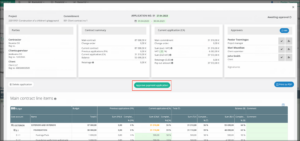Welcome, dear readers! If you’re here, you’re probably a construction project manager or a person deeply interested in the fascinating world of construction. Either way, you’re in the right place. Today, we’re going to delve into one of the most critical aspects of the construction industry: construction estimating.
To the untrained eye, a construction project might seem like a chaotic process where everything magically falls into place. But we know better, don’t we? Behind the scenes, there’s a meticulously planned and executed process, where every brick, every nail, and every hour of labor is accounted for. And that’s where a construction estimate comes into play.
A construction estimate is an essential tool in the construction industry. It sets the blueprint for the financial aspect of a project, outlining the potential costs associated with each step. A comprehensive estimate forms the backbone of effective budgeting, ensuring that the project doesn’t burn a hole in your pocket while still meeting the highest quality standards.
But as seasoned professionals would tell you, creating a precise construction estimate is often easier said than done. You need to account for a variety of factors, from labor costs and material prices to potential overheads and profit margins. A small miscalculation can snowball into a significant financial mishap, underscoring the importance of getting your construction estimates right.
In this guide, we aim to demystify the process of construction estimating. We’ll walk you through each step, helping you understand how to calculate costs accurately, avoid common pitfalls, and create a professional construction estimate that wins you contracts.
But that’s not all. We’ll also show you how leveraging cutting-edge construction management software like Bauwise can make the whole process more efficient and accurate.
So, grab a cup of coffee, sit back, and let’s start our journey towards mastering the art of construction estimating!
Understanding Construction Estimating
What do we mean when we say construction estimating? At its most basic level, construction estimating is the process of forecasting the total cost of a construction project. It’s a crucial component of construction management, used for everything from bidding on projects to determining whether a project is feasible.
Imagine for a moment that you’re embarking on a road trip. You wouldn’t just hop into your car and start driving, right? You’d probably plan your route, identify the places you want to visit, estimate how much gas you’ll need, and budget for meals and accommodations along the way. Similarly, a construction estimate allows you to plan and prepare for a construction project, mapping out what resources you’ll need and how much they will cost.
But why is construction estimating so important? Well, think about it. If you don’t accurately anticipate the costs of a project, you could end up with a half-built building and an empty bank account. On the other hand, if you overestimate, you might scare away potential clients with your high bids. Neither scenario is ideal.
The significance of construction estimating doesn’t end there. Not only does it help you avoid financial pitfalls, but it also aids in making critical decisions about the project. Accurate cost estimates allow you to assess project feasibility, plan your resources, manage risks, and strategize your bidding.
However, construction estimating isn’t just about crunching numbers. It involves a careful analysis of project requirements, market conditions, labor costs, material prices, and more. It requires a keen understanding of the construction process, an eye for detail, and, quite often, a bit of foresight.
The implications of inaccurate estimates can be severe. Underestimating can lead to cost overruns, project delays, or even complete project failure. Overestimating, as mentioned before, can cost you lucrative contracts. Therefore, understanding the nuances of construction estimating is a vital skill for any construction project manager or anyone aspiring to work in the construction industry.
Now that we’ve established the importance of construction estimating let’s dive deeper. In the next sections, we’ll walk you through the key elements of a construction estimate and the steps involved in creating one. So, buckle up and let’s dig in!
The Key Elements of a Construction Estimate
Alright, now that we’ve covered the what and why of construction estimating, it’s time to delve into the how. To accurately predict the cost of a construction project, there are several key elements you need to consider. These are like the building blocks that add up to your final estimate, each playing a critical role in the grand scheme of things. So let’s break down these elements one by one.
- Labor Costs: Your construction project isn’t going to build itself – you need skilled labor to bring your plans to life. This includes everyone from the project manager and site foreman to the carpenters, electricians, and masons who will be doing the actual building. The cost of labor is a significant chunk of your overall estimate and will depend on factors like local wage rates, labor productivity, and the complexity of the project.
- Materials: This one’s a no-brainer. You can’t build without materials. From concrete and steel to nails and paint, the cost of materials forms a large part of your estimate. Determining this cost involves estimating the quantities of different materials you’ll need (which can be a challenge in itself!) and then multiplying those quantities by the cost per unit. Remember, material costs can fluctuate based on market conditions, so it’s a good idea to keep an eye on trends.
- Equipment: Depending on the nature of your project, you might need a variety of equipment, from simple hand tools to heavy machinery. Each piece of equipment comes with associated costs, whether it’s purchasing, leasing, or just maintaining and operating them. Equipment costs often fly under the radar but they can add up quickly if you’re not careful.
- Overheads: Overhead costs are the necessary expenses that keep your construction business running but don’t directly contribute to any specific project. Think office rent, utilities, insurance, licenses, and administrative salaries. While they might not be linked to your project, they’re still part of the cost of doing business and thus need to be factored into your estimate.
- Profit Margin: Last but definitely not least, you need to account for a profit margin. After all, you’re not running a charity, right? A fair profit margin is the reward for your efforts and risks and helps you grow your business. But setting a profit margin isn’t just about picking a random number. It involves considering factors like the complexity of the project, potential risks, competition, and market conditions.
So there you have it, the key elements of a construction estimate. Each one is a cog in the machine, playing its part to create an accurate, comprehensive cost estimate. Neglecting even one of these can lead to inaccurate estimates and potentially cost you dearly.
In the upcoming sections, we’ll dive into the actual process of writing a construction estimate, but before we do that, we’ll tackle each of these elements in detail to give you a better understanding of how to calculate them. Let’s march forward, shall we?
Breaking Down the Elements: Labor Costs
Labor costs are a central part of any construction estimate, and it’s easy to see why. It takes many hands to transform a piece of land into a magnificent structure. Those hands need to be skilled, capable, and of course, compensated for their time and effort. In this section, we’re going to take a closer look at labor costs and how to calculate them effectively.
First, let’s discuss the types of labor you’ll need for a construction project. You’ll need a project manager to oversee the project, skilled workers like carpenters, masons, electricians, and plumbers to execute it, and unskilled laborers to support them. You might also need specialists for specific tasks, like architects or structural engineers. Each one of these roles comes with its own set of costs that need to be accurately accounted for in your estimate.
So, how do you calculate labor costs? It starts with understanding the tasks involved in your project and the amount of time each task will take. For example, if you know you’ll need a team of carpenters for two weeks, you can calculate the labor cost for that task by multiplying the number of carpenters by their daily wage and the number of days they’ll be working.
But there’s a little more to it than that. You also have to account for labor burdens – additional costs like taxes, insurance, and benefits. These are often expressed as a percentage of the basic labor cost. So, if your labor burden is 20%, and your basic labor cost for a task is $1000, your total labor cost for that task would be $1200.
A word of caution here. It’s important to be as precise as possible when estimating labor costs. Underestimating can lead to budget overruns, while overestimating can make your bids uncompetitive. You can refine your estimates by using historical data from past projects, considering local wage rates, and keeping in mind factors like the complexity of the project and the productivity of your workers.
Labor cost estimation can be a complex process, especially for larger projects with multiple teams and tasks. But fear not! Tools like construction management software, such as Bauwise, can simplify this process, providing you with an easy-to-use platform to manage your labor costs effectively. But more on that later.
In the next section, we’ll move onto the second key element of a construction estimate – materials. Let’s keep the ball rolling!
Breaking Down the Elements: Materials
From the concrete in the foundation to the paint on the walls, materials form the physical essence of any construction project. They are the bricks and mortar (quite literally) that bring your plans to life. As such, accurately estimating the cost of materials is a vital part of construction estimating. Let’s delve into this topic a bit deeper.
Estimating material costs starts with a detailed understanding of your project. You need to know what materials you’ll need, how much of each you’ll require, and how much each unit costs. This sounds simple enough, right? Well, here’s where it gets tricky.
Firstly, estimating the quantities of different materials you’ll need can be a challenge. It involves a detailed analysis of your project plans, a good understanding of construction methods, and often a bit of guesswork. This is where a detailed Bill of Quantities (BoQ) becomes invaluable. A BoQ is a document that lists out the quantities of each material needed for a project, forming the basis of your material cost estimate.
Secondly, the cost of materials can fluctuate. Factors like supply and demand, transportation costs, and even global economic conditions can cause the prices of common construction materials to swing. For example, the price of steel might be different when you start a project compared to when you finish it. This volatility adds an extra layer of complexity to material cost estimation.
So, how do you overcome these challenges? For estimating quantities, using tools like Computer-Aided Design (CAD) software can be extremely helpful. These programs can analyze your project plans and generate a detailed BoQ, saving you time and reducing the risk of errors.
As for price fluctuations, you can protect yourself by including contingencies in your estimate to account for potential price increases. Another approach is to lock in prices with your suppliers through purchase agreements, although this might not always be possible.
One last thing to note is the concept of waste. Not all materials purchased will end up in the final structure. Some will be wasted due to cutting losses, damage, theft, or simple human error. It’s important to factor in a certain amount of waste (typically between 5-10%) when estimating material costs.
As with labor costs, managing material costs can be a lot easier with the right tools. Construction management software, like Bauwise, can help you keep track of your material costs, alerting you to potential overruns and helping you make informed purchasing decisions.
Next up, we’ll be talking about equipment costs. Stick around, because there’s still plenty to learn!
Breaking Down the Elements: Equipment
The hum of machinery and the clink of tools are familiar sounds on a construction site. They signify progress, the transformation of plans into reality. However, this orchestra of productivity comes at a cost, one that needs to be factored into your construction estimate. So, let’s talk about equipment costs.
The type of equipment you’ll need for a project depends largely on the nature of the work. A small renovation job might only require basic tools, while a large-scale construction project could need everything from excavators to concrete mixers. Regardless, all equipment comes with associated costs.
When it comes to calculating equipment costs, you have a few different factors to consider. First, there’s the cost of acquiring the equipment. If you’re purchasing equipment, you’ll need to factor in the purchase price. If you’re renting, you’ll need to consider the rental rate.
But the cost of equipment doesn’t stop at acquisition. You also need to account for operation costs. This includes fuel and maintenance costs, as well as the cost of any necessary repairs. Remember, equipment that isn’t properly maintained can break down, leading to costly delays and unexpected expenses.
Moreover, just as with labor, you’ll need to think about the duration of equipment usage. An excavator that’s used for a week will cost less than one that’s used for a month. Accurately estimating how long you’ll need each piece of equipment can help you control costs.
Calculating equipment costs can be a bit of a juggling act, especially if you’re managing a large project with many different types of equipment. Thankfully, this is another area where construction management software like Bauwise can lend a helping hand. Such tools can help you track equipment usage, schedule maintenance, and manage rental agreements, making the whole process a lot smoother.
In the next section, we’re going to discuss overhead costs – an often overlooked, but crucial part of construction estimating. We’re making good progress, so let’s keep going!
Breaking Down the Elements: Overheads
It’s time to shift our focus onto an aspect of construction estimating that often flies under the radar but is crucial for the financial health of your construction business: overhead costs. While these costs don’t directly contribute to any specific project, they keep your business up and running. Let’s delve into what overhead costs are and how to account for them in your construction estimates.
Overhead costs are the ongoing expenses that you incur irrespective of whether you have a construction project in progress or not. Think of them as the cost of doing business. They include expenses like office rent, utilities, insurance, administrative salaries, marketing costs, and licensing fees. Even though these costs may not be directly tied to your construction projects, they’re still crucial to your operation and, thus, must be considered when preparing a construction estimate.
So, how do you incorporate overhead costs into your estimates?
The most common approach is to calculate your total annual overhead costs and then distribute that cost across your projects. For instance, if your total overhead costs for the year are $100,000 and you typically undertake ten projects per year, you might decide to allocate $10,000 of overhead costs to each project.
However, this method doesn’t consider that not all projects are created equal. A larger, more complex project might consume more resources and thus should carry a larger portion of the overhead. To account for this, you could allocate overhead costs based on the estimated labor hours or material costs of each project.
One thing to bear in mind is that your overhead costs should be covered by the project budget, but they should not be your profit. Your profit is the money you make after all costs, including overheads, have been covered.
Accounting for overhead costs accurately in your estimates ensures that your business remains profitable and sustainable. It’s another piece of the puzzle, contributing to a comprehensive, accurate construction estimate.
Next, we’ll be discussing the last major element of a construction estimate: profit margin. Don’t go anywhere; there’s more valuable information coming your way!
Breaking Down the Elements: Profit Margin
As we move to the final element of a construction estimate, let’s talk business. More specifically, let’s talk about profit margins. After all, your business isn’t a charity, and you need to make a profit to grow and prosper. But how do you decide what margin to include in your estimate? Let’s explore.
The profit margin is the amount you add to your cost estimate to determine the price you will charge your client. It’s your reward for the effort, time, and risks involved in undertaking a construction project.
Determining the right profit margin isn’t an exact science and can depend on a number of factors. These may include the complexity of the project, potential risks, market conditions, and competition. For example, a complex project with a higher risk of unexpected costs may require a higher profit margin to compensate for potential pitfalls.
While there’s no one-size-fits-all answer, many construction companies aim for a profit margin in the range of 10-20%. This can provide a good starting point, but it’s essential to adjust based on the specifics of each project and your business needs.
Here’s where some might get confused: profit margin and markup are not the same. Markup is a percentage of the costs, while profit margin is a percentage of the sales price. For example, if a project costs $100, and you add a 20% markup, the price will be $120 and your profit will be $20. But if you aim for a 20% profit margin on the same project, the price will be $125, because $25 is 20% of $125.
Remember, your profit margin needs to cover not just your profit but also any contingencies and potential cost overruns. Make sure your profit margin is both competitive and adequate to cover these additional costs.
Understanding your profit margin and appropriately incorporating it into your estimates is the final step in creating a comprehensive, accurate construction estimate.
Now that we’ve broken down the major elements of a construction estimate, it’s time to dive into the process of writing the estimate itself. Let’s get down to business!
The Process of Writing a Construction Estimate
With a firm understanding of the elements that make up a construction estimate, we’re now ready to tackle the process of writing the estimate itself. This process can be broken down into several steps, each of which requires careful attention and consideration. Buckle up and let’s dive in!
Step 1: Review and Understand the Project
The first step in writing a construction estimate is to thoroughly understand the project. This involves reviewing the project plans and specifications, visiting the construction site if possible, and speaking with the client to clarify any uncertainties. During this stage, it’s crucial to identify any potential challenges or issues that might impact costs, such as difficult site conditions or complex design elements.
Step 2: Prepare a Bill of Quantities
Next, you’ll need to prepare a detailed Bill of Quantities (BoQ). As we discussed earlier, a BoQ is a document that lists out the quantities of each material needed for a project. This can be a time-consuming task, especially for larger projects, but it’s a vital part of the estimating process. It’s the foundation upon which the rest of your estimate will be built.
Step 3: Calculate Material, Labor, and Equipment Costs
Once you have your BoQ, you can start calculating your material costs. This involves multiplying the quantity of each material by its unit cost. Don’t forget to account for waste!
Next, estimate your labor costs. This requires determining how much time each task will take and how many workers will be needed, then multiplying these by the appropriate wage rates.
Don’t forget about equipment. List out all the machinery and tools you’ll need, estimate how long you’ll need them, and factor in any additional operation costs.
Step 4: Account for Overhead Costs
As we discussed earlier, overhead costs are a necessary part of doing business. Allocate a portion of your overhead costs to the project, based on either a flat rate per project or as a proportion of labor or material costs.
Step 5: Determine Your Profit Margin
Finally, determine your profit margin. This should be a percentage of the total cost of the project, and should take into account factors like project complexity and potential risks.
By following these steps, you’ll create a comprehensive, detailed construction estimate that covers all aspects of the project. But remember, an estimate is just that – an estimate. It’s not a fixed price, and it’s likely that actual costs will vary. It’s crucial to regularly review and update your estimates as the project progresses.
We’re getting closer to wrapping up our guide on writing a construction estimate. Let’s move on to the final section, where we’ll discuss some tips and tricks to make the process smoother and more efficient!
Tips and Tricks for Effective Construction Estimating
We’ve covered a lot of ground in this guide, so you’re well on your way to becoming an estimating whiz. But as with anything in life, there’s always more to learn. So, as we wrap up, let’s take a look at some tips and tricks that can help you streamline the estimating process and increase your accuracy.
1. Stay Organized
First and foremost, organization is key. Keep your documents, notes, and data orderly and easily accessible. This not only saves time but also reduces the likelihood of errors. Consider using a system to keep track of all your project data, whether it’s a simple spreadsheet or a dedicated construction management software like Bauwise.
2. Don’t Overlook Small Details
The devil is often in the details. Even the smallest of items or tasks can add up over time and affect your project’s bottom line. Always double-check your work to ensure nothing has been missed.
3. Use Technology to Your Advantage
Today’s technology offers a host of tools that can make the estimating process more efficient and accurate. From CAD software that can help you generate a detailed BoQ, to construction management software that can track costs and identify potential overruns, there’s a wealth of resources at your disposal.
4. Learn from Past Projects
Past projects can provide a wealth of information for future estimates. They can give you a better understanding of how long tasks really take, what problems can arise, and how costs can fluctuate. Always take the time to review and learn from past projects.
5. Factor in Contingencies
Unexpected costs are almost a given in the construction industry. To protect yourself, it’s important to include a contingency allowance in your estimates. This is typically a percentage of the total project cost and is meant to cover any unforeseen expenses.
6. Keep Learning and Adapting
The construction industry, like any other, is constantly evolving. New technologies, materials, and methods are constantly being introduced. Stay up to date with the latest trends and innovations, and always be willing to adapt and improve your estimating processes.
Creating a detailed, accurate construction estimate is no easy task, but it’s a crucial part of running a successful construction business. By understanding the key elements of an estimate, following a systematic process, and utilizing these tips and tricks, you’ll be well-equipped to tackle this challenge.
Good luck, and happy estimating!
Putting It All Together
As we wrap up this comprehensive guide, it’s important to step back and appreciate the big picture. Construction estimating is not merely crunching numbers – it’s an art that requires a deep understanding of construction processes, keen attention to detail, and the ability to foresee potential challenges.
We’ve journeyed from understanding the basic elements of a construction estimate, including materials, labor, equipment, overhead costs, and profit margins, to navigating the step-by-step process of creating an estimate. Additionally, we’ve explored helpful tips and tricks to streamline the estimating process, improve accuracy, and leverage the power of past projects and modern technology.
Remember that every construction project is unique, and no estimate will ever be perfect. It’s essential to continually review and adjust your estimates as your project progresses, as well as to learn from each completed project to improve future estimates.
In this era of digital transformation, don’t forget to utilize the power of construction management software like Bauwise. Such tools can not only streamline and automate many aspects of the estimating process but can also provide valuable insights and analytics to guide decision-making.
Construction estimating is indeed a complex task, but with knowledge, practice, and the right tools, it can become a strength of your construction management skillset. After all, accurate and efficient estimates set the groundwork for successful projects, satisfied clients, and a thriving business.
We hope this guide has been insightful and that it aids you on your journey in construction project management. Always remember, “The bitterness of poor quality remains long after the sweetness of low price is forgotten.” Quality estimates lead to quality projects.
Thank you for sticking with us through this detailed guide. Happy estimating, and here’s to successful construction projects!
FAQ
What is a Construction Estimate?
A construction estimate is a comprehensive and detailed calculation of the potential costs involved in a construction project. It encompasses a wide range of factors, including the cost of materials, labor, and equipment, as well as overhead costs and profit margins. The process involves a thorough understanding of the project scope, preparing a detailed Bill of Quantities (BoQ), and factoring in contingencies for potential risks or unforeseen expenses. A precise construction estimate is crucial as it sets the financial groundwork for the project, aids in budgeting, informs the bidding process, and plays a significant role in the successful execution and completion of a construction project.
Why is a Construction Estimate Important?
A construction estimate is vital for several reasons. First and foremost, it provides a realistic prediction of the costs involved in a project, helping stakeholders to budget accurately and efficiently. It serves as a critical tool during the bidding process, allowing construction firms to price their services competitively while ensuring profitability. Moreover, a thorough and precise estimate can highlight potential challenges or risks before the project commences, allowing for proactive planning and problem-solving. Ultimately, accurate construction estimating contributes to improved project management, timely and on-budget project completion, and higher client satisfaction, all of which are crucial for the success and reputation of a construction firm.
What to Include in a Construction Estimate?
A comprehensive construction estimate should include several crucial elements. Firstly, it must detail the material costs, indicating the types and quantities of materials required along with their respective prices. Secondly, it needs to account for labor costs, reflecting the number of workers, their specializations, and wage rates. Thirdly, the estimate should include the cost of equipment and machinery needed for the project. Overhead costs, such as administrative expenses, office rent, utilities, and more, which contribute to the daily operations of a business, should also be factored into the estimate. Lastly, the estimate must account for profit margins, a critical component that ensures business profitability. It’s also good practice to include a contingency allowance to cover any unexpected expenses or cost overruns that may arise during the project.
How to Write a Construction Estimate?
Writing a construction estimate involves a systematic process that starts with thoroughly understanding the project. This involves studying project plans and specifications, and if possible, conducting site visits. The next step is preparing a Bill of Quantities (BoQ), which is a detailed list of materials needed for the project. Once you have your BoQ, calculate the material costs by multiplying the quantity of each material by its unit cost. Then, estimate your labor costs, which involves determining the number of workers needed, their wage rates, and the time it will take to complete each task. Don’t forget to include equipment costs as well, listing out all the tools and machinery needed and their associated costs. Subsequently, allocate a portion of your overhead costs to the project. Finally, determine your profit margin and include a contingency allowance for unforeseen expenses. Remember, an estimate is not set in stone and should be regularly reviewed and updated as the project progresses.





